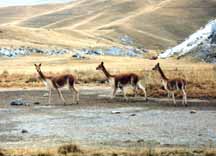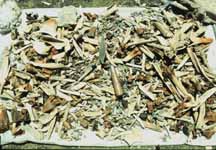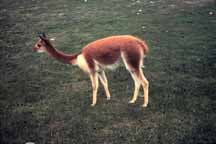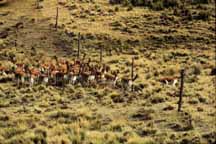camelids
 Camelids were an extremely important resource in the puna of the Andes, and played a major role in the life of the people. By the end of the Preceramic Period, the percentage of camelid bones found at base camps had risen from 70% to about 97%. Camelid meat clearly became the main source of protein for humans, camelid bones were in use as
tools
, and these animals are the most commonly depicted figure in preceramic rock
art
The vicuna, a deer-sized relative of the llama, is the probably the most important of the camelids in the puna during this time.
Camelids were an extremely important resource in the puna of the Andes, and played a major role in the life of the people. By the end of the Preceramic Period, the percentage of camelid bones found at base camps had risen from 70% to about 97%. Camelid meat clearly became the main source of protein for humans, camelid bones were in use as
tools
, and these animals are the most commonly depicted figure in preceramic rock
art
The vicuna, a deer-sized relative of the llama, is the probably the most important of the camelids in the puna during this time.
 Vicuna live in groups with a well defined social structure. There are two types of groups: bands and troops. The bands include an average of seven females and one dominant male, plus animals of both sexes under a year of age. Bands reside in fixed territories associated with permanent sources of water; the band animals remain in or near these territories on a year-round basis. Young animals attaining a year of age are expelled from the band by the male; the young females will soon be accepted into another band, while the young males join troops. Troops are groups of up to 40 males that hang around band territories and try to take the place of the currently dominant male. The band male has to constantly defend his position in the band. Vicuna of the central puna are year-round residents.
Vicuna live in groups with a well defined social structure. There are two types of groups: bands and troops. The bands include an average of seven females and one dominant male, plus animals of both sexes under a year of age. Bands reside in fixed territories associated with permanent sources of water; the band animals remain in or near these territories on a year-round basis. Young animals attaining a year of age are expelled from the band by the male; the young females will soon be accepted into another band, while the young males join troops. Troops are groups of up to 40 males that hang around band territories and try to take the place of the currently dominant male. The band male has to constantly defend his position in the band. Vicuna of the central puna are year-round residents.
 From 10,000 to 7,000 B.C. people were in the process of adapting to the puna and were lived in small, semi-mobile groups. Over these 3,000 years the groups seem to have settled down, coming to occupy single base-camp sites for long periods, perhaps hundreds of years or more. In order for these people to survive this length of time in
the same area, they had to limit their own population while not
over-hunting the vicuna.
From 10,000 to 7,000 B.C. people were in the process of adapting to the puna and were lived in small, semi-mobile groups. Over these 3,000 years the groups seem to have settled down, coming to occupy single base-camp sites for long periods, perhaps hundreds of years or more. In order for these people to survive this length of time in
the same area, they had to limit their own population while not
over-hunting the vicuna.
 To reach a reasonable balance between people and vicuna, the
people had to learn to take into account the vicuna social structure. If they randomly killed vicuna, reproductive groups would be broken and population would decline. Hunters had to focus on males from troops, and then reducing the size of the largest bands to avoid an imbalance between the animals and territorial grazing resources. This, among other adaptations to this cold, wet, and relatively non-seasonal environment let the preceramic people fill a long term niche with increasing sedentism.
To reach a reasonable balance between people and vicuna, the
people had to learn to take into account the vicuna social structure. If they randomly killed vicuna, reproductive groups would be broken and population would decline. Hunters had to focus on males from troops, and then reducing the size of the largest bands to avoid an imbalance between the animals and territorial grazing resources. This, among other adaptations to this cold, wet, and relatively non-seasonal environment let the preceramic people fill a long term niche with increasing sedentism.
|
 Camelids were an extremely important resource in the puna of the Andes, and played a major role in the life of the people. By the end of the Preceramic Period, the percentage of camelid bones found at base camps had risen from 70% to about 97%. Camelid meat clearly became the main source of protein for humans, camelid bones were in use as
tools
, and these animals are the most commonly depicted figure in preceramic rock
art
The vicuna, a deer-sized relative of the llama, is the probably the most important of the camelids in the puna during this time.
Camelids were an extremely important resource in the puna of the Andes, and played a major role in the life of the people. By the end of the Preceramic Period, the percentage of camelid bones found at base camps had risen from 70% to about 97%. Camelid meat clearly became the main source of protein for humans, camelid bones were in use as
tools
, and these animals are the most commonly depicted figure in preceramic rock
art
The vicuna, a deer-sized relative of the llama, is the probably the most important of the camelids in the puna during this time.



